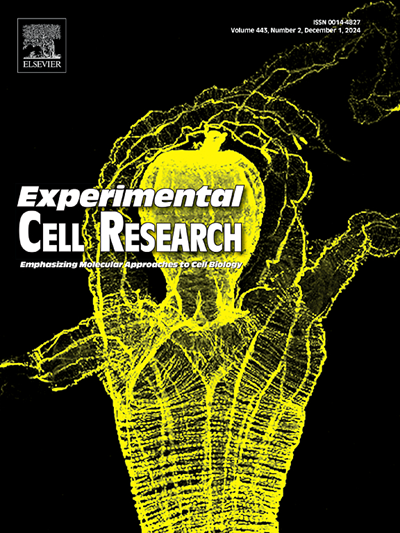在阿霉素诱导的肾病中,Fbxo11通过介导Fosl2的泛素降解来维持线粒体功能并防止荚膜细胞损伤。
IF 3.3
3区 生物学
Q3 CELL BIOLOGY
引用次数: 0
摘要
线粒体功能障碍是导致荚膜细胞损伤的关键因素,而荚膜细胞损伤是肾病综合征(NS)发病机制的核心组成部分。然而,荚膜细胞线粒体变化的确切机制仍然难以捉摸。我们的研究旨在阐明 F-box 蛋白 11(Fbxo11)在 NS 中发挥作用的潜在机制,特别是其对线粒体功能的影响。通过尾静脉注射阿霉素(ADR,10 毫克/千克)建立小鼠模型,并用过表达 Fbxo11 的慢病毒进行感染。用 lenti-Fbxo11-OE 感染小鼠荚膜细胞(MPC-5),然后用 0.4 μg/mL ADR 处理。我们确定了ADR诱导的小鼠肾组织和MPC-5细胞中Fbxo11表达的减少。Lenti-Fbxo11-OE干预缓解了ADR诱导的肾小球病变、荚膜细胞损伤和线粒体功能障碍。在体外,Fbxo11 在小鼠荚膜细胞中的过表达可改善线粒体功能,减少荚膜细胞损伤,从而抑制荚膜细胞凋亡。从机理上讲,Fbxo11通过泛素依赖性蛋白酶体降解减少了Fosl2的蛋白表达。拯救实验显示,Fosl2的过表达会取消Fbxo11过表达对线粒体损伤和荚膜细胞损伤的保护作用。重要的是,当使用线粒体分裂抑制剂 mdivi-1 处理时,Fbxo11/Fosl2 轴的调节作用被逆转。综上所述,我们的研究结果表明,Fbxo11 介导的 Fosl2 泛素降解对维持线粒体功能和防止 NS 期间的荚膜损伤至关重要。本文章由计算机程序翻译,如有差异,请以英文原文为准。
Fbxo11 maintains mitochondrial function and prevents podocyte injury in adriamycin-induced nephropathy by mediating the ubiquitin degradation of Fosl2
Mitochondrial dysfunction is a pivotal factor in the onset of podocyte damage, which is a central component in the pathogenesis of nephrotic syndrome (NS). However, the precise mechanisms underlying the changes in podocyte mitochondria remain elusive. Our study aims to clarify the potential mechanisms involved in the role of F-box protein 11 (Fbxo11) in NS, specifically concentrating on its impact on mitochondrial function. A mouse model was established by tail vein injection of adriamycin (ADR, 10 mg/kg) and was infected with lentivirus overexpressing Fbxo11 (lenti-Fbxo11-OE). Mouse podocytes (MPC-5) were infected with lenti-Fbxo11-OE, followed by treatment with 0.4 μg/mL of ADR. We identified the decreased expression of Fbxo11 in mouse renal tissues and MPC-5 cells induced by ADR. Lenti-Fbxo11-OE intervention relieved ADR-induced glomerular lesion, podocyte injury, and mitochondrial dysfunction. In vitro, overexpression of Fbxo11 in mouse podocytes improved mitochondrial function and reduced podocyte damage, thereby inhibiting podocyte apoptosis. Mechanistically, Fbxo11 decreased the protein expression of Fosl2 through ubiquitin-dependent proteasomal degradation. Rescue experiments revealed that overexpression of Fosl2 abolished the protective effects of Fbxo11 overexpression on mitochondrial damage and podocyte injury. Importantly, the regulatory effects of the Fbxo11/Fosl2 axis were reversed when treated with the mitochondrial fission inhibitor mdivi-1. Taken together, our results demonstrated that Fbxo11-mediated protein degradation of Fosl2 is critical for maintaining mitochondrial function and preventing podocyte injury during NS.
求助全文
通过发布文献求助,成功后即可免费获取论文全文。
去求助
来源期刊

Experimental cell research
医学-细胞生物学
CiteScore
7.20
自引率
0.00%
发文量
295
审稿时长
30 days
期刊介绍:
Our scope includes but is not limited to areas such as: Chromosome biology; Chromatin and epigenetics; DNA repair; Gene regulation; Nuclear import-export; RNA processing; Non-coding RNAs; Organelle biology; The cytoskeleton; Intracellular trafficking; Cell-cell and cell-matrix interactions; Cell motility and migration; Cell proliferation; Cellular differentiation; Signal transduction; Programmed cell death.
 求助内容:
求助内容: 应助结果提醒方式:
应助结果提醒方式:


